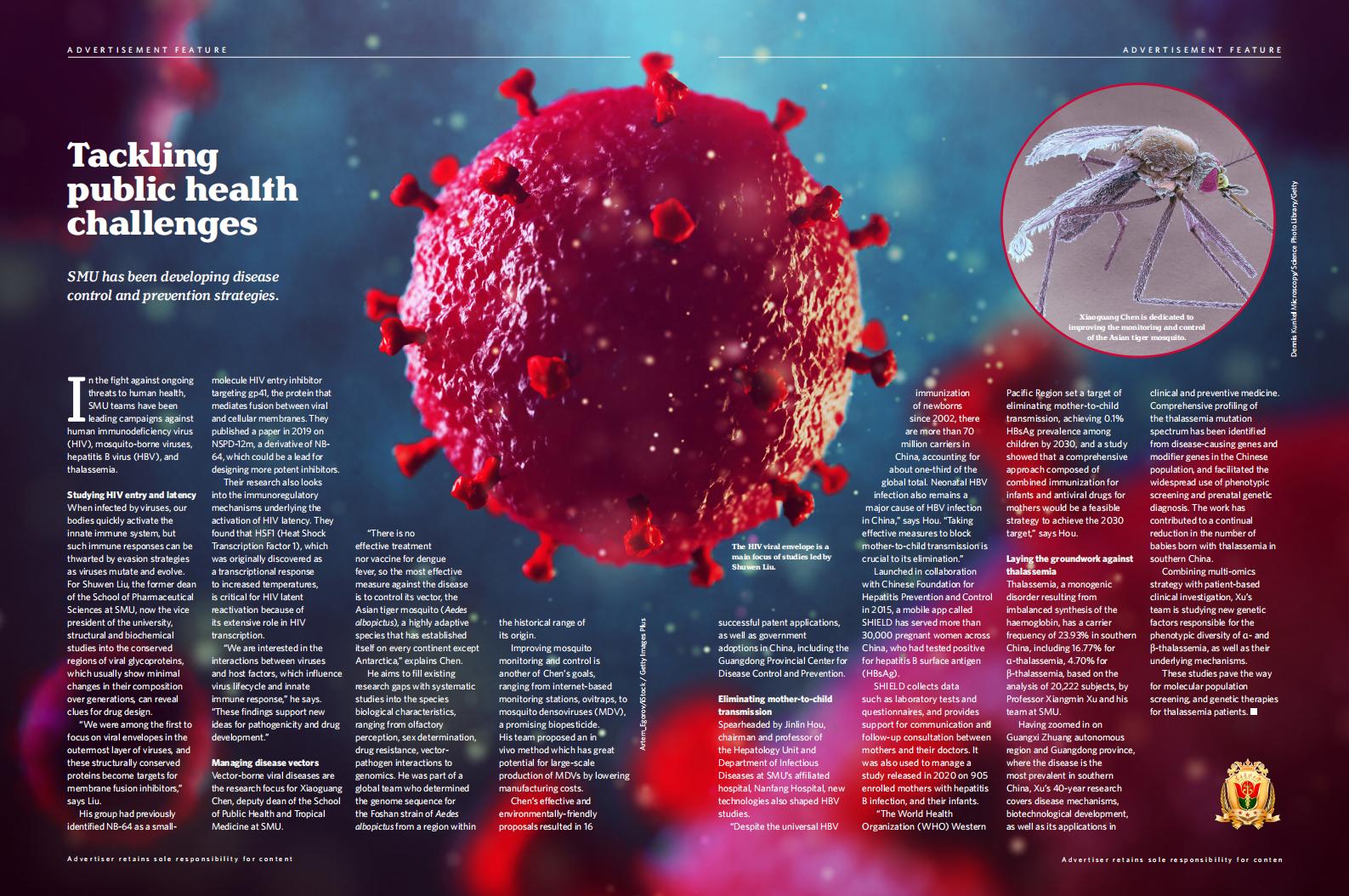Tackling public health challenges
SMU has been developing disease control and prevention strategies.
In the fight against ongoing threats to human health, SMU teams have been leading campaigns against human immunodeficiency virus (HIV), mosquito-borne viruses, hepatitis B virus (HBV), and thalassemia.

Studying HIV entry and latency
When infected by viruses, our bodies quickly activate the innate immune system, but such immune responses can be thwarted by evasion strategies as viruses mutate and evolve. For Shuwen Liu, the former dean of the School of Pharmaceutical Sciences at SMU, now the vice president of the university, structural and biochemical studies into the conserved regions of viral glycoproteins, which usually show minimal changes in their composition over generations, can reveal clues for drug design.
“We were among the first to focus on viral envelopes in the outermost layer of viruses, and these structurally conserved proteins become targets for membrane fusion inhibitors,” says Liu.
His group had previously identified NB-64 as a small molecule HIV entry inhibitor targeting gp41, the protein that mediates fusion between viral and cellular membranes. They published a paper in 2019 on NSPD-12m, a derivative of NB-64, which could be a lead for designing more potent inhibitors.
Their research also looks into the immunoregulatory mechanisms underlying the activation of HIV latency. They found that HSF1 (Heat Shock Transcription Factor 1), which was originally discovered as a transcriptional response to increased temperatures, is critical for HIV latent reactivation because of its extensive role in HIV transcription.
“We are interested in the interactions between viruses and host factors, which influence virus lifecycle and innate immune response,” he says. “These findings support new ideas for pathogenicity and drug development.”
Managing disease vectors
Vector-borne viral diseases are the research focus for Xiaoguang Chen, deputy dean of the School of Public Health and Tropical Medicine at SMU.
"There is no effective treatment nor vaccine for dengue fever, so the most effective measure against the disease is to control its vector, the Asian tiger mosquito (Aedes albopictus), a highly adaptive species that has established itself on every continent except Antarctica," explains Chen.
He aims to fill existing research gaps with systematic studies into the species biological characteristics, ranging from olfactory perception, sex determination, drug resistance, vector pathogen interactions to genomics. He was part of a global team who determined the genome sequence for the Foshan strain of Aedes albopictus from a region within the historical range of its origin.
Improving mosquito monitoring and control is another of Chen’s goals, ranging from internet-based monitoring stations, ovitraps, to mosquito densoviruses (MDV), a promising biopesticide. His team proposed an in vivo method which has great potential for large-scale production of MDVs by lowering manufacturing costs.
Chen’s effective and environmentally-friendly proposals resulted in 16 successful patent applications, as well as government adoptions in China, including the Guangdong Provincial Center for Disease Control and Prevention.
Eliminating mother-to-child transmission
Spearheaded by Jinlin Hou, chairman and professor of the Hepatology Unit and Department of Infectious Diseases at SMU’s affiliated hospital, Nanfang Hospital, new technologies also shaped HBV studies.
“Despite the universal HBV immunization of newborns since 2002, there are more than 70 million carriers in China, accounting for about one-third of the global total. Neonatal HBV infection also remains a major cause of HBV infection in China,” says Hou. “Taking ffective measures to block mother-to-child transmission is crucial to its elimination.”
Launched in collaboration with Chinese Foundation for Hepatitis Prevention and Control in 2015, a mobile app called SHIELD has served more than 30,000 pregnant women across China, who had tested positive for hepatitis B surface antigen (HBsAg).
SHIELD collects data such as laboratory tests and questionnaires, and provides support for communication and follow-up consultation between mothers and their doctors. It was also used to manage a study released in 2020 on 905 enrolled mothers with hepatitis B infection, and their infants.
“The World Health Organization (WHO) Western Pacific Region set a target of eliminating mother-to-child transmission, achieving 0.1% HBsAg prevalence among children by 2030, and a study showed that a comprehensive approach composed of combined immunization for infants and antiviral drugs for mothers would be a feasible strategy to achieve the 2030 target,” says Hou.
Laying the groundwork against thalassemia
Thalassemia, a monogenic disorder resulting from imbalanced synthesis of the haemoglobin, has a carrier frequency of 23.93% in southern China, including 16.77% for α-thalassemia, 4.70% for β-thalassemia, based on the analysis of 20,222 subjects, by Professor Xiangmin Xu and his team at SMU.
Having zoomed in on Guangxi Zhuang autonomous region and Guangdong province, where the disease is the most prevalent in southern China, Xu’s 40-year research covers disease mechanisms, biotechnological development, as well as its applications in clinical and preventive medicine. Comprehensive profiling of the thalassemia mutation spectrum has been identified from disease-causing genes and modifier genes in the Chinese population, and facilitated the widespread use of phenotypic screening and prenatal genetic diagnosis. The work has contributed to a continual reduction in the number of babies born with thalassemia in southern China.
Combining multi-omics strategy with patient-based clinical investigation, Xu’s team is studying new genetic factors responsible for the phenotypic diversity of α- and β-thalassemia, as well as their underlying mechanisms.
These studies pave the way for molecular population screening, and genetic therapies for thalassemia patients
https://www.nature.com/articles/d42473-021-00530-8